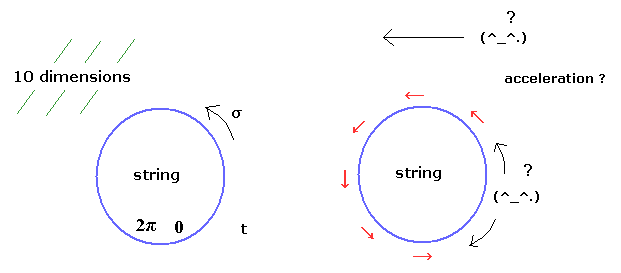
Top page (correct Bohr model including the two-electron atoms)
Strange "spin" is NOT a real thing
Superstring theory vs. Loop quantum gravity.
Ghosts and BRST transformations are real ?
In this page, we explain why string theory needs 26 critical dimension in boson ( 10 dimension in superstring ) from the viewpoint of gauge fixing, central charge and anomaly.
Basically, the path integral theory is very important in the string theory when we consider correlation function.
But this path integral method is completely useless, because we have to integrate the function with respect to every variable (from infinity to infinity) to keep symmetry.
If we fix one of these gauges, anomaly called "central charge" appears.
To keep symmetry, we have to get rid of this strange concept of central charge, which needs 26 (or 10) dimensions !
( But I think, mathematical "symmetry" needs to be abandoned, if it causes unreal extra-dimensions. )
(Fig.1) Superstring is NOT a real string !

First, 1 (= space) + 1 (= time) dimensional string in the world sheet is NOT real.
Because to express "circle" shape, we need at least 2 (= space) dimensions such as ( x, y ) and ( r, θ ).
So in this strange world sheet, a thing can not move in the direction of the string. ( See also this page. )
(Eq.0-1) Mathematical trick.

As shown in Eq.0-1, if we define artificial 1-dimensional ring, the infinite space integral of Eq.0-1 left can be expressed as simple 2π ( Eq.0-1 right ).
And in the conformal field theory, the space integral of 1-dimensional ring can be considered as complex integral of closed curve.
So only for the mathematical reason, this 1+1 dimensional string was chosen.
(Eq.0-2) Grassmann number "c".

Furthermore, the comformal field theory in the string uses the artificial Grassmann number to determine the very important dimensions of our world. ( See this page. )
The definition "1" of Fig.0-2 contradicts the definition "2" of Fig.0-2.
( If "1" is satisfied, "2" should be zero, too. But it is not zero. )
These definitions were introduced by our human beings, which do not mean the law of nature.
The two-dimensional string's position and size need to be arbitrary with respect to the target space (= 26 or 10 dimensional Minkowski background spacetime ).
So we can NOT express this string as a real thing due to the very abstract and strict mathematical symmetric conditions.
In this page, we use Euclidean coordinate, which is easily treated in the symmetric theory.
In this condition, by the Wick rotation of the time coordinate, Minkowski metric tensor changes into
(Eq.1)
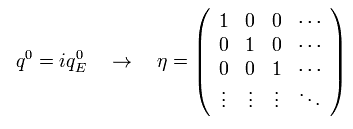
So we use ( 1, 1, 1 ..) version instead of ( -1, 1, 1, ...).
If the metric tensor g changes by some coordinate transformations like
(Eq.2)

This is called "conformal transformation".
As I said, two-dimensional worldsheet needs to be arbitrary with respect to the background.
So in all kinds of coordinates and length scales, this 2-D string needs to show the same reaction.
This strict symmetric conception removes "reality" from the string theory.
( Strict symmetry = NO reality. )
Under the infinitesimal conformal transformation of
(Eq.3)
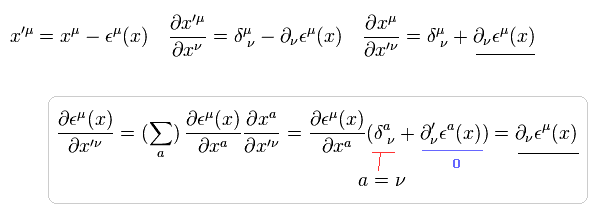
where we can neglect second order infinitesimals.
The metric tensor changes as
(Eq.4)
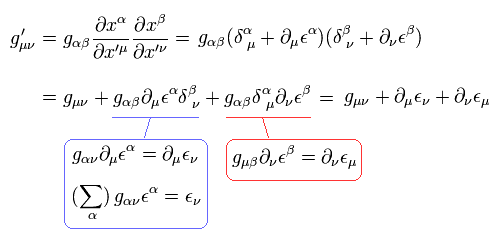
where we use
(Eq.5)

From Eq.2, Eq.4 satisfies
(Eq.6)

When ω's form is (A+B xμ), ε must be second-order with respect to x
(Eq.7)

Basically, translation, rotation, and scale transformations are expressed as
(Eq.8)

In the two-dimensional ( 1-space + 1-time ) worldsheet, the Euclidean metric tensor g is
(Eq.9)

And the metric tensor (contravariant) changes like
(Eq.10)

From Eq.2 and Eq.9, the following equations need to be satisfied
(Eq.11')
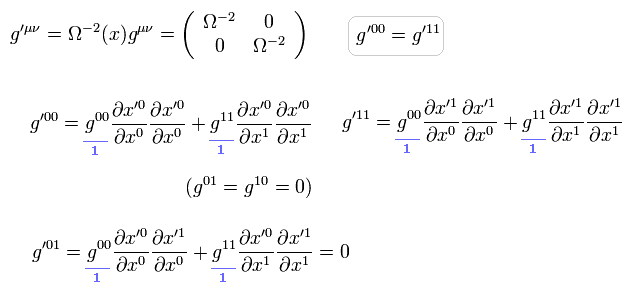
So,
(Eq.11)
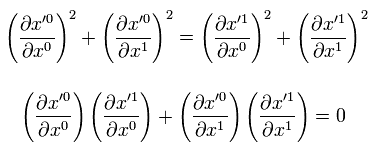
Eq.11 includes the equations of
(Eq.12)

Eq.12 is equal to Cauchy-Riemann equation in the complex plane of
(Eq.13)

If complex-valued z' after the coordinate transformation is complex-differentiable with respect to z, Eq.12 is automatically satisfied.
From Eq.13, the real-valued x0 (= time) and x1 (= space) can be expressed as
(Eq.14)

And we define the differential operators as
(Eq.15)

and
(Eq.16)

From Eq.9 and Eq.13, scalar length is
(Eq.17)

So the metric of z becomes
(Eq.18)

Generally the conformal transformation can be expressed as
(Eq.19)

For example, the translation is
(Eq.20)

Scale transformation + rotation is
(Eq.22)

The inversion is
(Eq.23)

When a field changes like
(Eq.24)

this field is called "primary field".
And "h" is called "conformal weight".
For example, covariant tensor (= bzz ) of this transformation is
(Eq.25)

this weight is "2" with respect to "h".
Next we think about the stress-energy (energy-momentum) tensor Tμν (first, 4D).
Stress energy tensor can be gotten from the action S invariance under various coordinate transformations.
When the infinitesimal coordinate transformation is
(Eq.26)

The change of the action S is
(Eq.27)

Jacobian matrix is a derterminant of the transformation like
(Eq.28)

where we neglect more than first-order infinitesimals.
The change of Lagrangian density L is
(Eq.29)
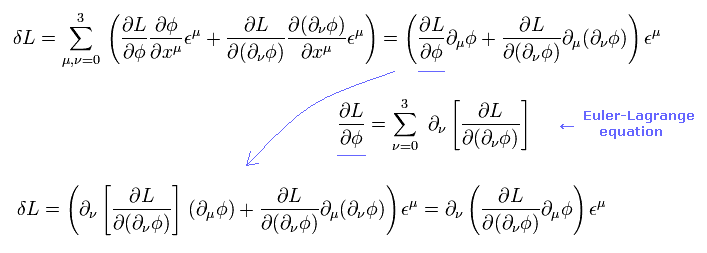
Here Euler-Lagrange equation is
(Eq.30)

From Eq.27, Eq.28 and Eq.29, we get
(Eq.31)

The action S is scalar under transformation ( S'-S = 0 ).
So we get the stress-energy tensor. (We can change its coefficient.)
When the z and bar-z of Eq.13 change (= infinitesimal) like
(Eq.32)

The primary field of Eq.24 changes as
(Eq.33)

So,
(Eq.34)

We define the infinitesimal change of the field as
(Eq.35)

From Eq.34 and Eq.35, the infinitesimal change of the field is
(Eq.36)
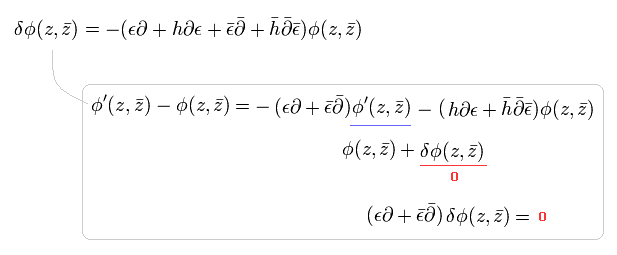
The correlation function can be expressed using the path integral method
(Eq.37)

where ψ mean integral variables.
(Fig.2) Path integral is a "real" physics ?
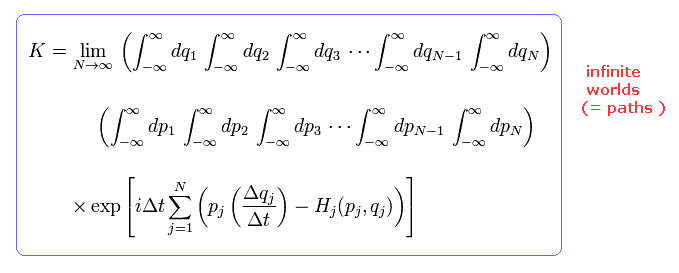
In the relativistic quantum field thery, the states between the initial and final functions need to include all kinds of states !
Of course, we have to integrate the function from minus infinity to inifnity in every variables.
To keep very strict symmetry, the functions have to include all states, they insist.
But do you think this many-world like path integral is a real physics and useful ?
Each integral variables include all kinds of states, so we can change them like
(Eq.38)

where we replace x by x', too.
From Eq.24 and Eq.38,
(Eq.39)

Using Eq.32, Eq.39 becomes
(Eq.40)

So
(Eq.41)

Next we think about the following infinitesimal change.
(Eq.42)

We define two-point correlation function as
(Eq.43)

When the infinitesimal transformation of Eq.42 is simple translation of
(Eq.44)

From Eq.41, Eq.43 and Eq.44,
(Eq.45)

ε and bar-ε are independent from each other.
So to satisfy Eq.45, the correlation function needs to be
(Eq.46)

where
(Eq.47)

This means G needs to be the function of (z = z1 - z2), and its bar- to satisfy translation symmetry.
Next we consider the scale transformation of
(Eq.48)

From Eq.41 and Eq.48, we have
(Eq.49)

From Eq.47 and Eq.49, z part equation becomes
(Eq.50)

Last, we consider the special conformal transformation of
(Eq.51)

From Eq.51 and Eq.41,
(Eq.52)

Using Eq.47 and Eq.50,
(Eq.53)

So we have
(Eq.54)

In this section, we treat free scalar field action (= bosons ).
This scalar boson field needs to be as much as 26 dimensions in the target space.
First, we treat one of 26 components.
In the Euclidean metric (Eq.9), the usual boson field action S is
(Eq.55)

In Euclidean metric, the index α position (up or down) is not important.
And in Eq.55, the metric g is fixed to Eq.9.
Because even if we do conformal transformation of Eq.2 to Eq.55, a square root of the metric determinant cancel the mertic change.
(= See this page ( Weyl symmetry Eq.40, Eq.47-Eq.49 ). change notation of gαβ to hαβ. )
In the complex plane of Eq.13, Eq.15, and Eq.18, the action S of Eq.55 changes into
(Eq.56)

Because considering Jacobian,
(Eq.57)

and
(Eq.58)

we prove Eq.55 is equal to Eq.56.
Using path integral method, we think about the X field change.
The correlation does not change under
(Eq.59)
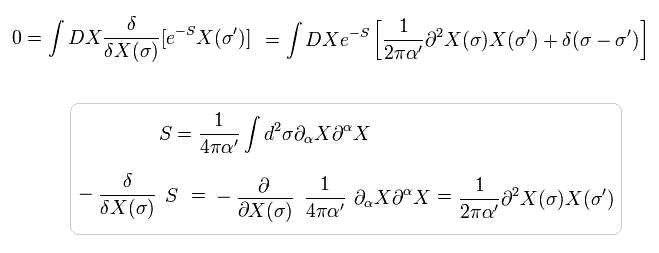
where we use Eq.55 action and do integration by parts, which changes sign.
( × 2 is caused by differentiation. )
And the functional drivative acts on the functions inside the integral like
(Eq.60)

From Eq.59, we have
(Eq.61)

Caution: this delta function is two-dimensional, and partial derivative is the sum of x0 and x1.
(Eq.61-2)

Here we use the following formula,
(Eq.62)

We prove Eq.62.
We first suppose σ' = 0.
Differentiating Eq.62 with respect to x0 and x1,
(Eq.63)
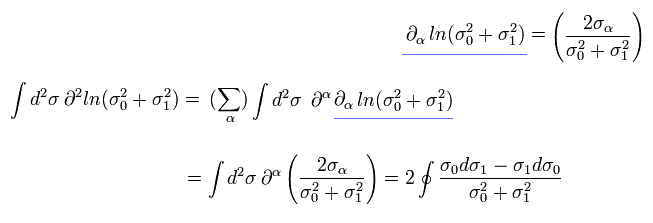
In the numerator of Eq.63, we use the following Green formula
( The denominator of Eq.63 is scalar under (1,1) metric tensor. )
(Eq.64)

(Fig.3) Counterclockwise line integral = c.
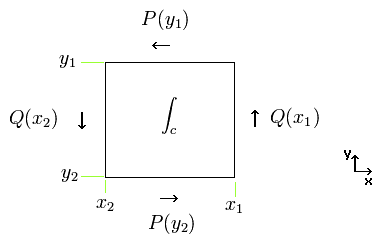
Based on Fig.3, the right side of Eq.64 is
(Eq.65)

this is equal to counterclockwise line integral.
Using the polar coordinate of
(Eq.66)

we get
(Eq.67)

As a result, we can prove Eq.62.
Substituting Eq.62 into Eq.61, we have
(Eq.68)

From Eq.56, Euler-Lagrange equation of Eq.30 becomes
(Eq.69)

this means X can be separated into z and bar-z terms.
From Eq.13,
(Eq.70)

Using Eq.70, we pick up only z term of Eq.68
(Eq.71)

From Eq.71, we have
(Eq.72)

Based on Eq.56 and Eq.31, the stress-energy tensor of scalar action is
(Eq.73)

where we multiply it by -2π
From Eq.72 and Eq.73, the operater product expansion (= OPE ) of T×T becomes
(Eq.74)

where : : means normal ordered product.
( You can forget this definition here. )
There are two ways of contractions ( X-X ), so "2" is added to Eq.74.
OPE is important when we consider correlation function.
And by the definition, "c" of Eq.74 is called "central charges", which is explained later.
This central charge influences critical dimension (boson, 26), they insist.
In case of Eq.74, scalar boson's central charge is "1". ( D dimension = 1 × D. )
But unfortunately, there are NO realities and clear images here.
To get calculation useful, we have to fix gauge and metric g.
To fix metric in some gauge, we use the delta function of
(Eq.75)

and
(Eq.76)

In this page (Ghosts and BRST transformations are real ?), we introduced the very strange concepts of ghosts and Grassmann numbers ( b, c ).
(Eq.77) Grassmann number's property.

And in the upper page, we get the ghost's action of
(Eq.78)

where bαβ∇αcβ forms "scalar".
The metric g is fixed to Eq.9 in the Euclidean spacetime (= gauge fixing ).
Using Eq.13, Eq.16, Eq.18 and Eq.57,
(Eq.79)

The ghost action of Eq.78 changes into
(Eq.80)

Here we define "b" as symmetric and traceless,
(Eq.81)

We change the notations like
(Eq.82)

Finally, we get the ghost action of
(Eq.83)

Based on the Euler-Lagrange equation of Eq.30 and Eq.83, we get the relations of
(Eq.84)

So b and c are functions of only z (= holomorphic fields).
Bar-b and bar-c are functions of only bar-z (= anti-holomorphic).
Like Eq.59, the correlation function of (b,c) can be gotten from
(Eq.85)

From Eq.83 and Eq.85, we have
(Eq.86)

In the same way,
(Eq.87)

where we use integration by parts and anti-commuting property.
From Eq.83, the following correlations ( b-b and c-c ) are zero,
(Eq.88)

Next we use the formula of
(Eq.89)

Integrating Eq.89 with respect to bar-z,
(Eq.90)

Using Eq.62 and Eq.70,
(Eq.91)

we can get Eq.90.
From Eq.86, Eq.87 and Eq.89, we get
(Eq.92)

where we use Eq.43 and Eq.46.
Using Eq.31 and Eq.83, the stress-energy tensor of the (b,c)-ghost is
(Eq.93)

Like Eq.73, we multiply by -2π.
In Eq.93, we use integration by parts and make derivatives of b and c (= variation of b and c ).
As a result, from Eq.93, the correlation of stress energy tensor pair (= TT ) becomes
(Eq.94)

Using Eq.92 and the following relations,
(Eq.95)

and
(Eq.96)

we have
(Eq.97)
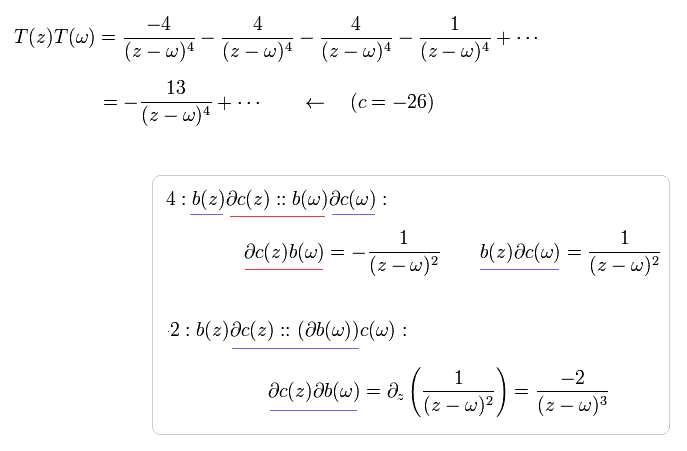
So, the central charge c of b,c-ghost is -26.
As shown in Eq.74, the central charge of D dimension scalar field is "D".
So to make the whole central charge zero, D needs to be 26 dimensions !
(Eq.98)

Unfortunately, there are no realities here.
( Also in case of fermions, they introduced the new ghost action in the same way and get 10 dimensions. )
First, (b,c)-ghost is just mathematical "ghost", so can we get the "physical" and real stress-energy tensor from that ghost ?
As I explained later, the zero central charge (c=0) is important for the symmetry in group theory.
(Eq.99)

See ( Virasoro algebra and central charge. )
If "c" of Eq.99 is not zero, Eq.99 is not beautiful for symmetry and group theory.
And as shown in this page (Eq.25, 26, 27, 31, 32), the existence of the central charge breaks the relations between the generator (Q) and some infinitesimal changes of the quantum mechanics.
So they insist the central charge of Eq.99 needs to be zero.
Instead, strange 26 dimensions (or 10 dimensions) have to be accepted !
Unfortunately, these are only "math", and NOT real.
( Which is more serious problem, extradimensions or asymmetry, you think ? )
Furthermore, they try to introduce "artificial" mathematical symmetries such as BRST invariance and supersymmetry.
So it seems that they are aiming ONLY at "mathematical" symmetries ( NOT reality ).

2012/8/22 updated. Feel free to link to this site.